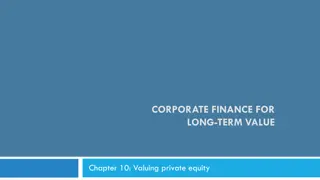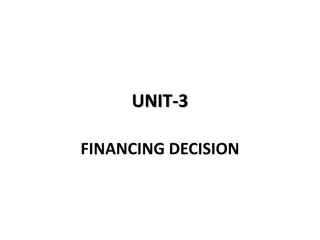
Exploring Debt & Equity Financing: Considerations and Trends in Business Deals
Dive into the world of debt and equity financing with insights on deal considerations and emerging trends from a seminar held in 2015. Discover expert advice on factors influencing financing decisions, the impact of market conditions, and navigating the changing financial environment. Gain valuable knowledge on funding size dynamics, commercial lending sources, and the evolving landscape of M&A activity.
Download Presentation

Please find below an Image/Link to download the presentation.
The content on the website is provided AS IS for your information and personal use only. It may not be sold, licensed, or shared on other websites without obtaining consent from the author. If you encounter any issues during the download, it is possible that the publisher has removed the file from their server.
You are allowed to download the files provided on this website for personal or commercial use, subject to the condition that they are used lawfully. All files are the property of their respective owners.
The content on the website is provided AS IS for your information and personal use only. It may not be sold, licensed, or shared on other websites without obtaining consent from the author.
E N D
Presentation Transcript
Debt & Equity-Financing The Deal: Considerations & Trends National Business Institute Seminar May 11, 2015
IronHorse is a K.C. based special situation professional services firm with practice specialties in business valuation & appraisal, forensic services & litigation support, CFO services, due diligence, and complex financial & operations restructuring/turnaround consulting. Tony is an Adjunct Professor of Accounting at Johnson Community College in Overland Park, KS and Rockhurst University in K.C. and serves on the Small Business Reorganization Committee as well as the Fraud Task Force with the American Institute of Bankruptcy. Tony Wayne, CVA, CPA, CIRA, CFF, FCPA President IronHorse LLC www.ihorsellc.com twayne@ihorsellc.com (913) 851-0027 IronHorse has performed numerous due diligence, valuation, litigation support and restructuring engagements for clients in a variety of industries. Tony has extensive M & A experience on dozens of transactions, especially with financially distressed enterprises.
Size Matters Easier to fund a $ 15 million deal than a $ 2 million deal. Private equity sources generally want to put at least $ 5-8 million of their money to work. Universe of small capital providers is specialized, scattered and expensive. Costs about the same in terms of time to search, solicit, secure $ 500,000 as it does $ 5 million
Factors Quality of earnings Volatility Quality of collateral available Assessment of senior executive and management capability Demonstrated capability to service debt Degree of operating and financial leverage, liquidity and solvency Financial and internal operating control environment Conditions in capital markets Availability of guarantees, other assets to be pledged Valuation multiple trends. Commercial lending source; bank vs alternative capital provider.
Factors Conditions in capital markets Availability of guarantees, other assets to be pledged Valuation multiple trends. Commercial lending source; bank vs alternative capital provider.
Changing Environment Loan to value limitations Covenants Access availability requirements (Collateral cushion) Stretch-pieces (over-advance) Balloons Subordinated soft notes Carry-backs Earn-outs Sub-debt Bank vs ABL : regulatory environment
Deal Trends (M&A) activity has accelerated meaningfully in the U.S. That trend is poised to continue, if not accelerate. Cash is flush Deal multiples climbing More leverage More creative leverage Covenant-light debt Stretch pieces & airballs Haircuts Hedge fund & other debt buyers Junior lien alternatives
Capital Structure Considerations Required rates of return & cost of funding Commercial collateralized debt Bonds Subordinated & convertible debt Preferred equity Common equity Eligible assets to pledge Guarantees
Typical Loan Covenants Debt service coverage ratio LTV limits Inventory collateral limits Ineligibles Equipment advance rates Real estate advance rates Borrowing base Leverage ratio Tangible net worth
Typical Loan Covenants Debt service coverage ratio LTV limits Inventory collateral limits Ineligibles Equipment advance rates Real estate advance rates Borrowing base Leverage ratio Tangible net worth
SBA Financing Small deals Tough/cumbersome to source & place Time consuming Advantages Alternatives: Second tier ABL s Conventional C and I debt with guarantees Friends & family Angel funding
Asset-based Bank sources Commercial finance companies Tiered providers based on size Pricing/costs Quasi factors Factors One-off sources P.O. financing
Subordinated (Mezzanine) Debt Usually unsecured Warrants Convertability SBIC s Costs Coupon PIC feature Fees Success fee
Equity Friends & family Angel funds Individual angels Private equity sponsor groups Control Size & critical mass matter Success rates in placing How to improve the odds
Special Situation Deals Debt buyers Turnaround sources Bridge capital Haircuts Subordinated soft notes Lender as equity player Carry-back financing Cleansing; article nine, going concern sales in receivership, section 363 deals, foreclosures






















